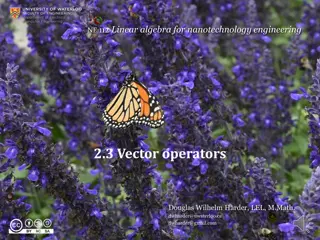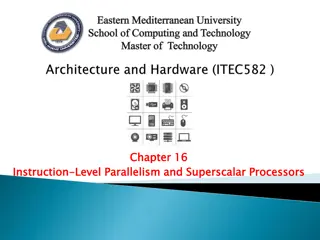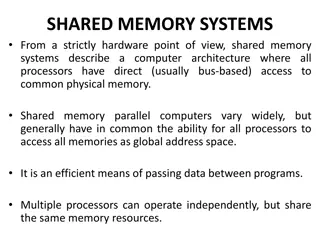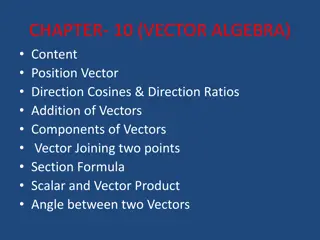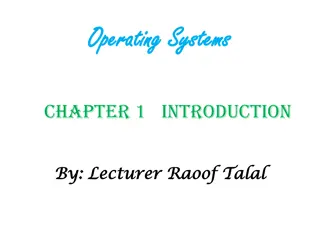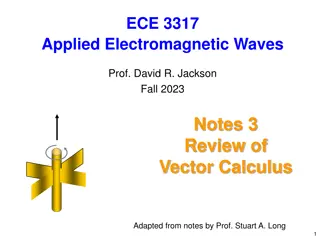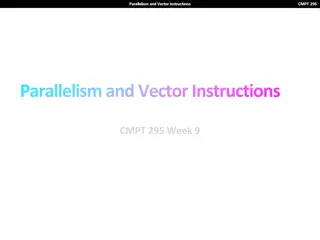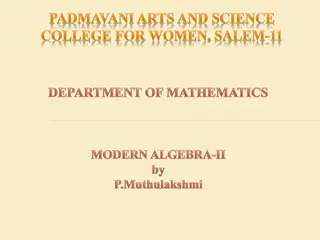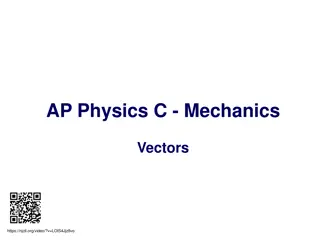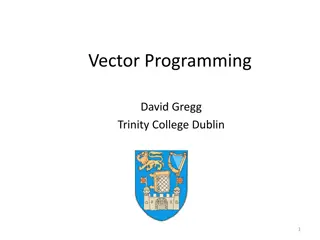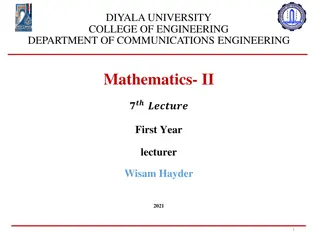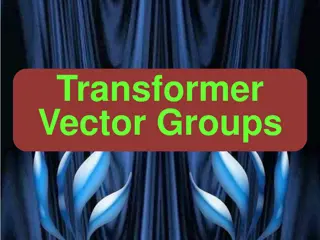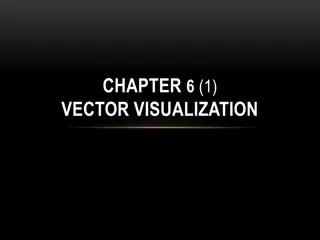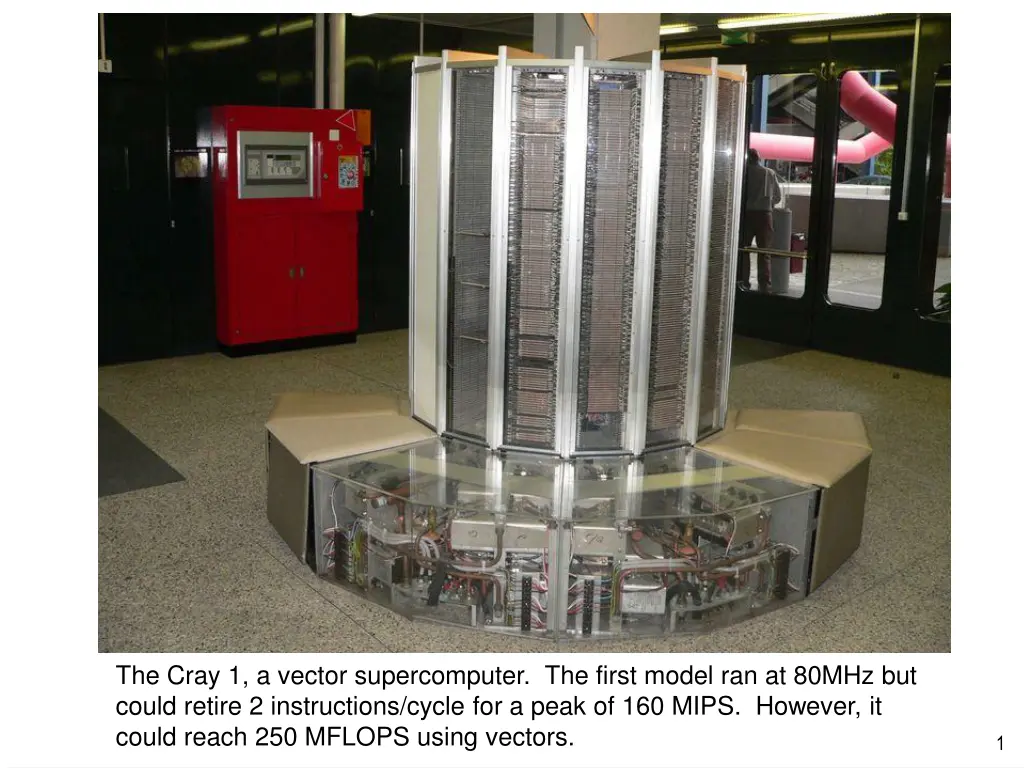
Understanding Vector Supercomputers: The Cray-1 and Beyond
Delve into the world of vector supercomputers with a focus on the iconic Cray-1 model. Explore its capabilities in executing instructions, peak performance levels, and applications in military, scientific research, weather forecasting, and more. Learn about the vector programming model, code examples, and the efficiency of vector arithmetic execution pipelines.
Download Presentation

Please find below an Image/Link to download the presentation.
The content on the website is provided AS IS for your information and personal use only. It may not be sold, licensed, or shared on other websites without obtaining consent from the author. If you encounter any issues during the download, it is possible that the publisher has removed the file from their server.
You are allowed to download the files provided on this website for personal or commercial use, subject to the condition that they are used lawfully. All files are the property of their respective owners.
The content on the website is provided AS IS for your information and personal use only. It may not be sold, licensed, or shared on other websites without obtaining consent from the author.
E N D
Presentation Transcript
The Cray 1, a vector supercomputer. The first model ran at 80MHz but could retire 2 instructions/cycle for a peak of 160 MIPS. However, it could reach 250 MFLOPS using vectors. 1
COMP 740: Computer Architecture and Implementation Montek Singh Nov 16, 2016 Topic: Vector Processing 2
Traditional Supercomputer Applications Typical application areas Military research (nuclear weapons, cryptography) Scientific research Weather forecasting Oil exploration Industrial design (car crash simulation) All involve huge computations on large data sets In 70s-80s, Supercomputer Vector Machine 3
Vector Supercomputers Epitomized by Cray-1, 1976: Scalar Unit + Vector Extensions Load/Store Architecture Vector Registers Vector Instructions Hardwired Control Highly Pipelined Functional Units Interleaved Memory System No Data Caches No Virtual Memory 4
Vector Programming Model Scalar Registers r15 Vector Registers v15 r0 v0 [0] [1] [2] [VLRMAX-1] VLR Vector Length Register v1 Vector Arithmetic Instructions v2 + + + + + + ADDV v3, v1, v2 v3 [0] [1] [VLR-1] Vector Load/Store instr LVWS v1, (r1, r2) LV v1, r1 Vector Register v1 Memory Base, r1 Stride, r2 6
Vector Code Example # Vector Code LI VLR, 64 LV V1, R1 LV V2, R2 ADDV.D V3, V1, V2 SV V3, R3 # Scalar Code LI R4, 64 loop: L.D F0, 0(R1) L.D F2, 0(R2) ADD.D F4, F2, F0 S.D F4, 0(R3) DADDIU R1, 8 DADDIU R2, 8 DADDIU R3, 8 DSUBIU R4, 1 BNEZ R4, loop # C code for (i=0; i<64; i++) C[i] = A[i] + B[i]; 7
Vector Arithmetic Execution Use deep pipeline (=> fast clock) to execute element operations Simplifies control of deep pipeline because elements in vector are independent (=> no hazards!) V1 V2 V3 Six stage multiply pipeline V3 <- v1 * v2 8
Vector Instruction Execution ADDV C,A,B Execution using one pipelined functional unit Execution using four pipelined functional units A[6] B[6] A[24] B[24] A[25] B[25] A[26] B[26] A[27] B[27] A[5] B[5] A[20] B[20] A[21] B[21] A[22] B[22] A[23] B[23] A[4] B[4] A[16] B[16] A[17] B[17] A[18] B[18] A[19] B[19] A[3] B[3] A[12] B[12] A[13] B[13] A[14] B[14] A[15] B[15] C[2] C[8] C[9] C[10] C[11] C[1] C[4] C[5] C[6] C[7] C[0] C[0] C[1] C[2] C[3] 9
Vector Unit Structure Functional Unit (e.g., adders) Vector Registers Elements 0, 4, 8, Elements 1, 5, 9, Elements 2, 6, 10, Elements 3, 7, 11, Lane Functional Unit (e.g., multipliers) Vector load-store unit (Memory Subsystem) 10
Vector Memory-Memory vs. Vector Register Vector memory-memory instructions hold all vector operands in main memory The first vector machines, CDC Star-100 ( 73) and TI ASC ( 71), were memory-memory machines Cray-1 ( 76) was first vector register machine Vector Memory-Memory Code Example Source Code ADDV C, A, B SUBV D, A, B for (i=0; i<N; i++) { C[i] = A[i] + B[i]; D[i] = A[i] - B[i]; } Vector Register Code LV V1, A LV V2, B ADDV V3, V1, V2 SV V3, C SUBV V4, V1, V2 SV V4, D 11
Vector Memory-Memory vs. Vector Register Vector memory-memory architectures (VMMA) require greater main memory bandwidth, why? All operands must be read in and out of memory VMMAs make if difficult to overlap execution of multiple vector operations, why? Must check dependencies on memory addresses Apart from CDC follow-ons (Cyber-205, ETA-10) all major vector machines since Cray-1 have had vector register architectures (we ignore vector memory-memory from now on) 12
Automatic Code Vectorization for (i=0; i < N; i++) C[i] = A[i] + B[i]; Scalar Sequential Code Vectorized Code load load load load Iter. 1 load load Time add add add store store store load Iter. 1 Iter. 2 Vector Instruction load Iter. 2 Vectorization is a massive compile-time reordering of operation sequencing requires extensive loop dependence analysis add store 13
Vector Strip Mining Problem: Vector registers have finite length Solution: Break loops into pieces that fit into vector registers, Strip mining ANDI R1, N, 63 # N mod 64 MTC1 VLR, R1 # Do remainder loop: LV V1, RA DSLL R2, R1, 3 DADDU RA, RA, R2 # Bump pointer LV V2, RB DADDU RB, RB, R2 ADDV.D V3, V1, V2 SV V3, RC DADDU RC, RC, R2 DSUBU N, N, R1 # Subtract elements LI R1, 64 MTC1 VLR, R1 # Reset full length BGTZ N, loop # Any more to do? for (i=0; i<N; i++) C[i] = A[i]+B[i]; A B C # Multiply by 8 Remainder + 64 elements + + 14
Vector Instruction Parallelism Can overlap execution of multiple vector instructions example machine has 32 elements per vector register and 8 lanes Load Unit Multiply Unit Add Unit load mul add time load mul add Instruction issue Complete 24 operations/cycle while issuing 1 short instruction/cycle 15
Vector Chaining Vector version of register bypassing introduced with Cray-1 V 1 V 2 V 3 V 4 V 5 LV v1 MULV v3,v1,v2 ADDV v5, v3, v4 Chain Chain Load Unit Mult. Add Memory 16
Vector Chaining Advantage Without chaining, must wait for last element of result to be written before starting dependent instruction Load Mul Time Add With chaining, can start dependent instruction as soon as first result appears Load Mul Add 17
Memory operations Load/store operations move groups of data between registers and memory Types of addressing Unit stride Contiguous block of information in memory Fastest: always possible to optimize this LV v1, r1 Non-unit (constant) stride Harder to optimize memory system for all possible strides Prime number of data banks makes it easier to support different strides at full bandwidth LVWS v1, (r1, r2) 18 32
Vector Memory System Cray-1, 16 banks, 4 cycle bank busy time, 12 cycle latency Bank busy time: Cycles between accesses to same bank Base Stride Vector Registers Address Generator + 0 1 2 3 4 5 6 7 8 9 A B C D E F Memory Banks 19
Interleaved Memory Layout Great for unit stride: Contiguous elements in different DRAMs Startup time for vector operation is latency of single read What about non-unit stride? Above good for strides that are relatively prime to 16 Bad for: 2, 4, 8 Better: prime number of banks ! 20
Vector Scatter/Gather Want to vectorize loops with indirect accesses: for (i=0; i<N; i++) A[i] = B[i] + C[D[i]] Indexed load instruction (Gather) LV vD, rD # Load indices in D vector LVI vC, rC, vD # Load indirect from rC base LV vB, rB # Load B vector ADDV.D vA, vB, vC # Do add SV vA, rA # Store result 21
Vector Conditional Execution Problem: Want to vectorize loops with conditional code: for (i=0; i<N; i++) if (A[i]>0) then A[i] = B[i]; Solution: Add vector mask (or flag) registers vector version of predicate registers, 1 bit per element and maskable vector instructions vector operation becomes NOP at elements where mask bit is clear 22
Masked Vector Instructions Simple Implementation execute all N operations, turn off result writeback according to mask Density-Time Implementation scan mask vector and only execute elements with non-zero masks M[7]=1 M[7]=1 A[7] B[7] M[6]=0 M[6]=0 A[6] B[6] A[7] B[7] M[5]=1 M[5]=1 A[5] B[5] M[4]=1 M[4]=1 A[4] B[4] C[5] M[3]=0 M[2]=0 M[1]=1 M[0]=0 M[3]=0 A[3] B[3] C[4] M[2]=0 C[2] C[1] M[1]=1 C[1] Write data port M[0]=0 C[0] Write Enable Write data port 23
Compress/Expand Operations Compress packs non-masked elements from one vector register contiguously at start of destination vector register population count of mask vector gives packed vector length Expand performs inverse operation A[7] A[5] M[7]=1 A[7] A[7] M[7]=1 M[6]=0 A[6] B[6] M[6]=0 A[4] M[5]=1 A[5] A[5] M[5]=1 A[1] M[4]=1 A[4] A[4] M[4]=1 M[3]=0 M[2]=0 M[1]=1 M[0]=0 A[3] A[2] A[7] A[5] B[3] B[2] M[3]=0 M[2]=0 M[1]=1 M[0]=0 A[1] A[4] A[1] A[0] A[1] B[0] Compress Expand 24
Vector Reductions Problem: Loop-carried dependence on reduction variables sum = 0; for (i=0; i<N; i++) sum += A[i]; # Loop-carried dependence on sum Solution: Re-associate operations if possible, use binary tree to perform reduction # Rearrange as: sum[0:VL-1] = 0 # Vector of VL partial sums for(i=0; i<N; i+=VL) # Stripmine VL-sized chunks sum[0:VL-1] += A[i:i+VL-1]; # Vector sum # Now have VL partial sums in one vector register do { VL = VL/2; # Halve vector length sum[0:VL-1] += sum[VL:2*VL-1] # Halve no. of partials } while (VL>1) 25
Vector Execution Time Time = f(vector length, data dependencies, struct. hazards) Initiation rate: rate that FU consumes vector elements (= number of lanes; usually 1 or 2 on Cray T-90) Convoy: set of vector instructions that can begin execution in same clock (no struct. or data hazards) Chime: approx. time for a vector operation m convoys take m chimes; if each vector length is n, then they take approx. m x n clock cycles (ignores overhead; good approximization for long vectors) 1: LV V1,Rx 2: MULV V2,F0,V1 ;vector-scalar mult. LV V3,Ry 3: ADDV V4,V2,V3 ;add 4: SV Ry,V4 ;load vector X 4 convoys, 1 lane, VL=64 => 4 x 64 = 256 clocks (or 4 clocks per result) ;load vector Y ;store the result 26
Older Vector Machines Machine Year Clock Regs Elements Cray 1 1976 Cray XMP 1983 120 MHz Cray YMP 1988 166 MHz Cray C-90 1991 240 MHz Cray T-90 1996 455 MHz Convex C-1 1984 Convex C-4 1994 133 MHz Fuj. VP200 1982 133 MHz Fuj. VP300 1996 100 MHz NEC SX/2 1984 160 MHz NEC SX/3 1995 400 MHz FUs 6 8 8 8 8 4 3 3 3 16 16 80 MHz 8 8 8 8 8 8 16 64 64 64 128 128 128 128 10 MHz 8-256 8-256 8+8K 8+8K 32-1024 32-1024 256+var 256+var 27
Newer Vector Computers Cray X1 & X1E MIPS like ISA + Vector in CMOS NEC Earth Simulator Fastest computer in world for 3 years; 40 TFLOPS 640 CMOS vector nodes 28
Key Architectural Features of X1 New vector instruction set architecture (ISA) Much larger register set (32x64 vector, 64+64 scalar) 64- and 32-bit memory and IEEE arithmetic Based on 25 years of experience compiling with Cray1 ISA Decoupled Execution Scalar unit runs ahead of vector unit, doing addressing and control Hardware dynamically unrolls loops, and issues multiple loops concurrently Special sync operations keep pipeline full, even across barriers Allows the processor to perform well on short nested loops Scalable, distributed shared memory (DSM) architecture Memory hierarchy: caches, local memory, remote memory Low latency, load/store access to entire machine (tens of TBs) Processors support 1000 s of outstanding refs with flexible addressing Very high bandwidth network Coherence protocol, addressing and synchronization optimized for DM 29
Cray X1E Mid-life Enhancement Technology refresh of the X1 (0.13 m) ~50% faster processors Scalar performance enhancements Doubling processor density Modest increase in memory system bandwidth Same interconnect and I/O Machine upgradeable Can replace Cray X1 nodes with X1E nodes 30
Earth Simulator A general-purpose supercomputer: 1. Processor Nodes (PN) Total number of processor nodes is 640. Each processor node consists of eight vector processors of 8 GFLOPS and 16GB shared memories. Therefore, total numbers of processors is 5,120 and total peak performance and main memory of the system are 40 TFLOPS and 10 TB, respectively. Two nodes are installed into one cabinet, size is 40 x56 x80 . 16 nodes are in a cluster. Power consumption per cabinet is approximately 20 KW. 2) Interconnection Network (IN): Each node is coupled together with more than 83,000 copper cables via single-stage crossbar switches of 16GB/s x2 (Load + Store). The total length of the cables is approximately 1,800 miles. 3) Hard Disk. Raid disks are used for the system. The capacities are 450 TB for the systems operations and 250 TB for users. 4) Mass Storage system: 12 Automatic Cartridge Systems (STK PowderHorn9310); total storage capacity is approximately 1.6 PB. From Horst D. Simon, NERSC/LBNL, May 15, 2002, ESS Rapid Response Meeting 31
Multimedia Extensions Very short vectors added to existing ISAs for micros Usually 64-bit registers split into 2x32b or 4x16b or 8x8b Newer designs have 128-bit registers (Altivec, SSE2) Limited instruction set: no vector length control no strided load/store or scatter/gather unit-stride loads must be aligned to 64/128-bit boundary Limited vector register length: requires superscalar dispatch to keep multiply/add/load units busy loop unrolling to hide latencies increases register pressure Trend towards fuller vector support in microprocessors 35
Vector Instruction Set Advantages Compact one short instruction encodes N operations Expressive, tells hardware that these N operations: are independent use the same functional unit access disjoint registers access registers in the same pattern as previous instructions access a contiguous block of memory (unit-stride load/store) access memory in a known pattern (strided load/store) Scalable can run same object code on more parallel pipelines or lanes 36
Operation & Instruction Count: RISC v. Vector Processor Spec92fp Operations (Millions) Instructions (Millions) Program RISC Vector R/V swim256 115 95 hydro2d 58 40 nasa7 69 41 su2cor 51 35 tomcatv 15 10 wave5 27 25 mdljdp2 32 52 RISC Vector R/V 115 0.8 58 0.8 69 2.2 51 1.8 15 1.3 27 7.2 32 15.8 1.1x 1.4x 1.7x 1.4x 1.4x 1.1x 0.6x 142x 71x 31x 29x 11x 4x 2x Vector reduces ops by 1.2X, instructions by 20X (from F. Quintana, U. Barcelona.) 37
Vectors Lower Power Vector Single-issue Scalar One instruction fetch, decode, dispatch per operation Arbitrary register accesses, adds area and power Loop unrolling and software pipelining for high performance increases instruction cache footprint All data passes through cache; waste power if no temporal locality One TLB lookup per load or store Off-chip access in whole cache lines One inst fetch, decode, dispatch per vector Structured register accesses Smaller code for high performance, less power in instruction cache misses Bypass cache One TLB lookup per group of loads or stores Move only necessary data across chip boundary 38
Superscalar: Worse Energy Efficiency Vector Superscalar Control logic grows quadratically with issue width Control logic consumes energy regardless of available parallelism Speculation to increase visible parallelism wastes energy Control logic grows linearly with issue width Vector unit switches off when not in use Vector instructions expose parallelism without speculation Software control of speculation when desired: Whether to use vector mask or compress/expand for conditionals 39
Vector Applications Limited to scientific computing? No! Multimedia Processing (compress., graphics, audio synth, image proc.) Standard benchmark kernels (Matrix Multiply, FFT, Convolution, Sort) Lossy Compression (JPEG, MPEG video and audio) Lossless Compression (Zero removal, RLE, Differencing, LZW) Cryptography (RSA, DES/IDEA, SHA/MD5) Speech and handwriting recognition Operating systems/Networking (memcpy, memset, parity, checksum) Databases (hash/join, data mining, image/video serving) Language run-time support (stdlib, garbage collection) even SPECint95 40
Vector Summary Vector is alternative model for exploiting ILP If code is vectorizable, then simpler hardware, more energy efficient, and better real-time model than Out-of-order machines Design issues include number of lanes, number of functional units, number of vector registers, length of vector registers, exception handling, conditional operations Fundamental design issue is memory bandwidth Will multimedia popularity revive vector architectures? 41

